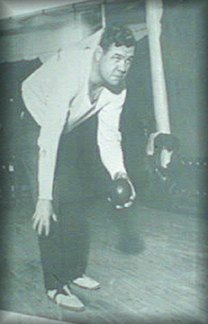 THE HISTORY OF
DUCKPIN BOWLING
THE HISTORY OF
DUCKPIN BOWLING
Duckpin bowling was born in Baltimore, Maryland, has been around since 1900.
It was one of Babe
Ruth's favorite games, besides baseball, of course! Ten-pin bowling
used to be strictly a winter sport. Most alleys closed down for the summer,
but a few of them remained open so that bowlers could practice with small
balls, about 6 inches in diameter. They usually played odd games called "back
five," using just the 5, 7, 8, 9, and 10 pins, and "cocked hat," which used
only the 1, 7, and 10.
In 1900, summer bowlers at the Diamond Alleys in Baltimore suggested it might
be interesting to trim down the standard pins to match the size of the ball.
Manager John Van Sant liked the idea. He had a wood turner do the job and
many of his customers enjoyed the new bowling game. At first, the rules of
ten-pin bowling were used. But, because it's much harder to get strikes and
spares, one small rule change was made: A bowler is allowed to use three
bowls on each turn. If all ten pins are knocked down with three balls, it
simply counts a score of ten.
Van Sant demonstrated the new sport to the owners of the alley, John McGraw
and Wilbert Robinson. Though they're much better known as baseball managers,
McGraw and Robinson were also avid duck hunters. When they saw the way the
small pins flew wildly around the alley, one of them remarked that it looked
liked a "flock of flying ducks."
That was the beginning of duckpin bowling. Originally a summer sport, it
became so popular in the area that winter leagues were organized in Baltimore
in 1903 and in Washington, D. C., in 1904. During the 1920s, duckpin bowling
spread along the east coast, from New England to Georgia. While the rules
were basically the same everywhere, balls, pins, and lane sizes weren't
standardized.
The National Duckpin Bowling Congress (NDBC), founded in the fall of 1927,
worked with member organizations and manufacturers to bring about
standardization. The NDBC held its first national tournament, patterned after
the American Bowling Congress's ten-pin tournament, in the spring of 1928.
There were 126 five-person teams, 162 doubles teams, and 201 singles entries.
Duckpin bowling grew rapidly during the 1930s.
By 1938, an estimated 200,000 bowlers were participating in sanctioned league
play. Growth continued more slowly after World War II, reaching a peak of
300,000 sanctioned bowlers in 1967. The sport's popularity has declined greatly
since then, but it's still strong in a narrow geographical region from Washington
and Baltimore to Connecticut and Rhode Island.
A variation, rubberband duckpin bowling, developed during the late 1930s.
The pins are circled with bands of hard rubber that increase pin action and
scores. In 1946, the NDBC created an affiliate, the American Rubberband Duckpin
Bowling Congress, to sanction leagues and conduct a national tournament.
The rubberband version of the sport never spread very far beyond the
Baltimore-Washington area.
Bowling History courtesy of:
Hickock's Sports
History
Photo of Babe Ruth taken by Robin Olson, of a poster at
White Oak Lanes